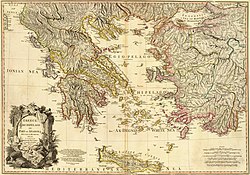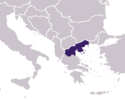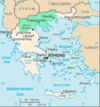This is an old revision of this page, as edited by Future Perfect at Sunrise (talk | contribs) at 17:47, 30 March 2007 (rv, anthem has its own page and is linked to). The present address (URL) is a permanent link to this revision, which may differ significantly from the current revision.
Revision as of 17:47, 30 March 2007 by Future Perfect at Sunrise (talk | contribs) (rv, anthem has its own page and is linked to)(diff) ← Previous revision | Latest revision (diff) | Newer revision → (diff) This article is about the region of Greece. For Macedonia, see Macedonia (Greece) (disambiguation).For an explanation of terms related to Macedonia, see Macedonia (terminology).Makedonía Macedonia | ||||||||
|---|---|---|---|---|---|---|---|---|
| ||||||||
| ||||||||
| Capital | Thessaloniki File:Thessaloniki seal.png | |||||||
| Peripheries | West Macedonia Central Macedonia East Macedonia | |||||||
| Population | 2,625,681 (2005) | |||||||
| Area | 34,231 km² | |||||||
| Population density | 77/km² | |||||||
Macedonia (IPA /ˌmæsəˈdoʊ̯nɪə/, Greek: Μακεδονία, Makedonia) is the largest and second most populous region of Greece. Together with the regions of Thrace and Epirus, it is often referred to unofficially as northern Greece. It is located at coordinates 40°45′N 22°54′E / 40.750°N 22.900°E / 40.750; 22.900.
Its territory covers most of the original northern Greek region of ancient Macedonia. Its name was later imparted to a wider Balkan region that became known in modern times as Macedonia of which it forms 52.4% of the land and 52.9% of the population. It was part of the Ottoman Empire until 1912. In 1913, most of the Ottoman lands in Europe were divided between the surrounding countries of Greece, Serbia, Bulgaria, Albania and Montenegro.
Local government
Macedonia is divided into three peripheries comprising thirteen prefectures or nomoi. The prefectures are further divided into demoi (municipalities) or koinotetes (roughly equivalent to British or Australian shires). The geographical region of Macedonia also includes the male-only autonomous monastic republic of Mount Athos, but this is not part of the Macedonia precincts. Indeed, Mount Athos lies outside the jurisdiction of most Greek and European laws. Due to the whole mountain's monastic status, it is inaccessible to women.

The three Macedonian peripheries and their prefectures are:
- West Macedonia, comprising:
- Central Macedonia, comprising:
- 5. Pella
- 6. Imathia
- 7. Pieria
- 8. Kilkis
- 9. Thessaloniki
- 10. Chalcidice
- 11. Serres
- and East Macedonia and Thrace, two prefectures of which are in Macedonia:
These are overseen by the national government's Ministry of Macedonia and Thrace.
Macedonia borders the neighboring peripheries of Thessaly and Epirus.
Geography

Macedonia covers an area of some 34,231 km² (13,217 square miles). High ground makes up much of the region with mountains reaching up to 2,900 m (6,500 ft); extensive fertile plains lie along the Aegean Sea coast. Macedonia is traversed by the valleys of the Aliakmon, Axios, Nestos, and Strymonas rivers, all of which drain into the Aegean. It borders the countries of Albania, the Former Yugoslav Republic of Macedonia and Bulgaria, and the Greek provinces of Epirus, Thessaly and Thrace. The offshore island of Thasos is within the precincts of Macedonia; together with Samothrace, they belong to the region of Eastern Macedonia and Thrace (Ανατολική Μακεδονία και Θράκη)'.
The region has a population of 2,625,681, and its capital and largest city is Thessaloniki, with a population of around 773,180.
Since World War II, Greek Macedonia is sometimes called Aegean Macedonia, a term introduced by Tito in 1945 to lay claim on Greek Macedonia and in the build up to the Greek civil war. Although this term is now used mostly by Macedonian Slavs and occasionally in historical contexts, it is strongly disliked by many Greeks (particularly Macedonians), who remember that after WWII, Tito's communist Yugoslavia began to remove the 'Greek' qualifying term in order to justify territorial claims against Greek Macedonia.
| Part of a series on the |
|---|
| History of Greece |
 |
| Neolithic Greece |
Greek Bronze Age
|
Ancient Greece
|
Medieval Greece
|
Early modern Greece
|
Modern Greece
|
| History by topic |
|
|

| Other major Macedonian towns and cities (Population) | |
| 1. Thessaloniki (with an approximate population) | 1,000,000 |
| 2. Kavala | 63,774 |
| 3. Serres | 56,145 |
| 4. Katerini | 55,721 |
| 5. Drama | 55,632 |
| 6. Kozani | 47,451 |
| 7. Veria | 47,411 |
| 8. Ptolemaida | 32,775 |
| 9. Giannitsa | 26.296 |
| 10. Edessa | 25,619 |
| 11. Kilkis | 24,812 |
| 12. Naoussa | 19,870 |
| 13. Nea Moudania | 17,032 |
| 14. Florina | 16,711 |
| 15. Kastoria | 16,218 |
| 16. Grevena | 15,481 |
| 17. Alexandria | 13,229 |
| 18. Polygyros | 10,271 |
The capital

Thessaloniki, Thessalonica or Salonica (Greek: Θεσσαλονίκη) is the capital of the Greek region of Macedonia and the second-largest city of Greece. It is also the capital of the Thessaloniki prefecture and the capital of the EU region (or, synonymously, Greek periphery) of Central Macedonia. Today's population of the city's metropolitan area is around 1,000,000.
Thessaloniki is a thriving, vibrant city and its commercial port is of a strategic importance for Greece. It is a major economic, industrial, commercial and cultural center as well as a transportation hub in southeastern Europe. The city hosts a large student population and it is widely renowned for its large number of monuments of Byzantine architecture as well as its eminent nightlife.
Economy and Transport

Despite its rugged terrain, Macedonia possesses some of the richest farmland in Greece in the plain of Drama and the valleys of the Strimon and Axios. A wide variety of foodstuffs and cash crops are grown, including rice, wheat, beans, olives, cotton, tobacco, fruit, grapes, wine and other alcoholic beverages. Food processing and textile weaving constitute the principal manufacturing industries. Tourism is a major industry along the coast, particularly in the Chalcidice peninsula, the island of Thasos and the northern approaches to Mount Olympus. Many tourists originate from Greece's immediate neighbors.
Thessaloniki is a major port city and industrial center; Kavala is the other harbor of Macedonia. Apart from the principal airport at Thessaloniki (Makedonia Airport), airports also exist in Kavala (M.Alexandros Airport), Kozani (Filippos Airport), and Kastoria (Aristotelis Airport). The "Via Egnatia" motorway crosses the full distance of Macedonia, linking its main cities.
History

- Main articles: Macedonia (region), Kingdom of Macedon and the rise of Macedon
The history of Greek Macedonia is very long, from ancient to modern Greece. It started with the Kingdom of Macedonia, (that was reorganised by Philip II), through the empire of Alexander the Great, continues within the Roman and Byzantine empires, the domination of the Ottomans (from 14th century until 1912) and the Balkan Wars.
Modern History
- Main articles: History of Modern Greece, History of Modern Macedonia, Macedonian Struggle, Balkan Wars, Greek Civil War and the Macedonian Question
Etymology
- Main article: Etymology of the name of Macedonia

There are three theories for the etymology of the name Macedonia:
- According to ancient Greek mythology, Macedon was the name of the first phylarch (tribal chief) of the tribe that initially settled western, southern and central Macedonia and founded the kingdom of Macedon.
- Αccording to Herodotus, the Makednoí were a tribe of the Dorians. The name probably derives from the Doric adjective Template:Polytonic makednós, meaning "tall" since both the Macedonians (Makedónes) and their Makednoí tribal ancestors were regarded as tall people. The adjective is used by Homer in Odyssey (7.105f), to describe a tall poplar tree, and by Aristophanes in his comedy the Birds, to describe a wall built around their imaginary city.
- An unattested hypothesis suggests that the name Makedónes may mean "highlanders", from a hypothetical Macedonian bahuvrihi *Template:Polytonic *maki-kedónes "of the high earth". However, there is serious argumentation against this hypothesis.
Macedonian cuisine
- Main article: Greek Macedonian cuisine. See also: Macedonian salad
Demographics


The inhabitants are overwhelmingly ethnic Greeks (Greek Macedonians) and most are members of the Greek Orthodox Church. From the Middle Ages to the early 20th century, the ethnic composition of the region of Macedonia is characterized by uncertainty both about numbers and identification. The 1904 Ottoman census of Hilmi Pasha recorded 373,227 Greeks and 204,317 Bulgarians in the vilayet of Selânik (Thessaloniki) alone, while it makes no mention of a Macedonian Slav ethnicity (which at the time was regarded as Bulgarian). According to the same census, Greeks were also dominant in the vilayet of Manastır (Bitola), counting 261,283 Greeks and 178,412 Bulgarians. Hugh Poulton, in his Who Are the Macedonians, notes that "assessing population figures is problematic" for the territory of Greek Macedonia before its incorporation into the Greek state in 1913 . The area's remaining population was principally composed of Ottoman Turks and also some Jews, and at much smaller numbers of Roma, Albanians and Vlachs.
During the first half of the twentieth century, major demographic shifts took place, which resulted in the region's population becoming overwhelmingly ethnic Greek. In 1919, Bulgaria and Greece signed the Treaty of Neuilly, which called for an exchange of populations between the two countries. According to the treaty, Bulgaria was considered to be the parent state of all ethnic Slavs living in Greece. Most ethnic Greeks from Bulgaria were resettled in Greek Macedonia; most Slavs were resettled in Bulgaria but a number, remained, most of them by changing or adapting their surnames and declaring themselves to be Greek so as to be exempt from the exchange. In 1923 Greece and Turkey signed the Treaty of Lausanne, and hundreds of thousands of Greeks from Anatolia were resettled in the region replacing Macedonian Turks and other Muslims (of Albanian, Greek, Roma, Slavic and Vlach ethnicity) under similar terms.
Macedonian cities during Ottoman rule were often known by multiple names (Greek, Slavic or Turkish by the respective populations). After the partition of Ottoman Europe, cities in Greece became officially known only by their Greek names, and cities in Bulgaria and the Kingdom of Yugoslavia became likewise officially known only in the languages of their respective states. After the population exchanges, many locations were renamed to the languages of their new occupants.
The population was badly affected by the Second World War through starvation, executions, massacres and deportations. Nazi-aligned Bulgaria's occupation forces persecuted the local Greek population and settled Bulgarian colonists in their occupation zone in eastern Macedonia and western Thrace, deporting all Jews from the region. Total civilian deaths in Macedonia are estimated at over 400,000, including 55,000 Greek Jews. Further heavy fighting affected the region during the Greek Civil War which, combined with post-war poverty, drove many inhabitants of rural Macedonia to emigrate either to the towns and cities, or abroad. Even today, many parts of Macedonia are fairly sparsely inhabited.
Greek is by far the most widely spoken and the only official language of public life and education in Macedonia. There are also some smaller linguistic communities, including speakers of Macedonian Greek, Pontian Greek, Aromanian, Megleno-Romanian, Arvanitic, Armenian, Slavic, Turkish, Russian, Ladino and Romani.
Since the fall of communism throughout Eastern Europe in the late 1980s and early 1990s, a large number of economic refugees and immigrants from Greece's neighboring countries, Albania, Bulgaria, the Former Yugoslav Republic of Macedonia, Romania and Serbia, as well as from more distant countries such as Russia, the Ukraine, Armenia and Georgia, have arrived in Greece (including Macedonia) to seek employment.
The exact size of the minority groups of Macedonia is unclear, as Greece has not conducted a census on the question of mother tongue since 1951. The main minority groups in Macedonia are:
- Vlachs (Aromanians and Megleno-Romanians), who largely identify as Greeks and belong to the Greek Orthodox Church. In the 1951 census they numbered 39,855 in all Greece (the number in Macedonia proper is unknown).
- Slavophones, who largely identify as Greeks and belong to the Greek Orthodox Church. In the 1951 census they numbered 41,017 in all Greece, mostly in Western Macedonia. The linguistic classification of the dialects spoken by these people oscillates from Bulgarian to Macedonian Slavic depending on location, although the people themselves call their language Slavic. This group has received a lot of attention in recent years due to the claims of the Former Yugoslav Republic of Macedonia that these people are in fact an ethnic Macedonian minority in Greece. A political party promoting the concept and rights of what they describe as the "Macedonian minority in Greece" - the Rainbow (Ουράνιο Τόξο) - was founded in September 1998, and received 2,955 votes in Macedonia in the 2004 elections. Similarly, a pro-Bulgarian political party, known as Bulgarian Human Rights in Macedonia (Βουλγαρικά Ανθρώπινα Δικαιώματα στη Μακεδονία) was established in June 2000, promoting the concept and rights of what they describe as the "Bulgarian minority in Greece". This party has yet to participate in elections.
Other minority groups include Arvanites (who like the Vlachs identify ethnically as Greeks), Jews (Sephardim and Romaniotes), Armenians and Roma.
See also
Notes and references
- EUROPA - The EU at a glance - Maps - Greece - Anatoliki Makedonia ke Thraki
- ^ Poulton, Hugh (2000). "Greece". In Second (ed.). Who Are the Macedonians?. Indiana University Press. pp. 85–86. ISBN 0-253-21359-2.
External links
- Region of Central Macedonia
- Region of Western Macedonia
- Region of Eastern Macedonia and Thrace
- Macedonian information center
- The truth about Macedonia
- Macedonian Press Agency
- Museums of Macedonia
- Video from Tileasti:Macedonia - The History
- Nikolaos Martis - Macedonia's Hellenism: Empirical documents and sources
- Why Macedonia is Hellenic
- University of Macedonia
- University of Western Macedonia
- An online review of Macedonian affairs, history and culture
- Pan-Macedonian Network
- #Macedonia on IRC EFnet
- Animated Map of the History of Macedonia
- Macedonia, The Historical Profile of Northern Greece
- Serres Prefecture
- Macedonia, Greece - History And Politics - eBook Greek Language (ISBN:960-6-0337-5)
- Map of Makedonia
- City of Thessaloniki
- City of Edessa
- City of Serres
- Technological Educational Institution of Serres
- Department of Physical Education Sience & Athletics of Serres
- Alistrati Cave in Serres
- Lake Kerkini in Serres - Kerkini Wetland (Ramsar & Natura 2000 Protected)
- Map of Macedonia
- Macedonia guide for visitors
- Macedonia On The Web
- Roman province of Macedonia
- Macedonia.com
- Macedonia
- Information of Macedonia
- Travel info of Macedonia
| Regions of Greece | ||
|---|---|---|
| Regions | ||
| Autonomous regions | ||



